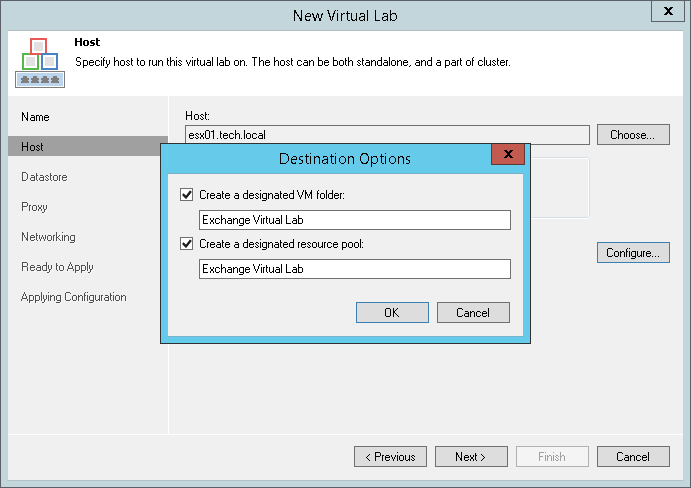 This is an archive version of the document. To get the most up-to-date information, see the current version.
This is an archive version of the document. To get the most up-to-date information, see the current version.Step 3. Select Host
At the Host step of the wizard, select an ESX(i) host on which the virtual lab must be created.
To select an ESX(i) host:
- Click Choose.
- Select an ESX(i) host on which the new virtual lab must be created. You can select a standalone ESX(i) host or an ESX(i) host being part of a cluster or vCenter Server hierarchy.
- For every new virtual lab, Veeam Backup & Replication creates a dedicated folder and resource pool on the ESX(i) host. By default, the folder and pool have the same name as the virtual lab. To change the name of the folder and/or resource pool, click Configure. In the Destination Options window, enter the necessary names.
|
You cannot create resource pools in clusters with disabled DRS. If the destination host is a part of such a cluster, the Create a designated resource pool option will be disabled in the Destination Options window. For more information, see http://kb.vmware.com/kb/1004098. |

Selecting an ESX(i) Host for VM Replicas Verification
When you select an ESX(i) host for the virtual lab where VM replicas will be verified, mind the location of verified VM replicas and VM replicas added to the application group:
- If verified VM replicas and VM replicas from the application group are located on the same ESX(i) host, you must select the ESX(i) host on which these VM replicas are registered. Verified VM replicas and VMs from the application group will be started on the selected ESX(i) host. If the application group contains VMs added from VM backups or storage snapshots, these VMs will also be started on the selected ESX(i) host.
For this type of virtual lab configuration, you need to choose one of single-host networking modes: Basic single-host or Advanced single-host. For more information, see Selecting a Networking Mode.
- If verified VM replicas and/or VM replicas from the application group are located on different ESX(i) hosts, you can select any ESX(i) host in your virtual environment. Veeam Backup & Replication will create the virtual lab on the selected ESX(i) host. Verified VM replicas and VM replicas from the application group will be started on ESX(i) hosts where they are registered and connected to the virtual lab with the help of VMware DVS technology.
The ESX(i) host on which the virtual lab is created must meet the following requirements:
- The ESX(i) host must be located in the same datacenter where VM replicas are registered.
- The ESX(i) host must have enough CPU and RAM resources. If the application group contains VMs that are started from backups or storage snapshots, these VMs will be started on the same ESX(i) host where the virtual lab is located, which will require a lot of resources.
- For this type of virtual lab configuration, you must use the Advanced multi-host networking mode. For more information, see Selecting a Networking Mode.